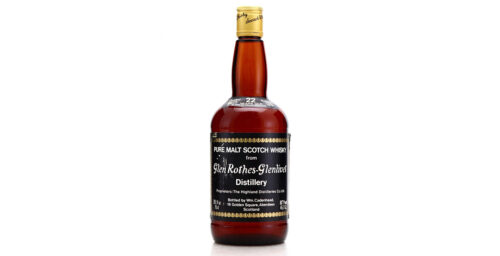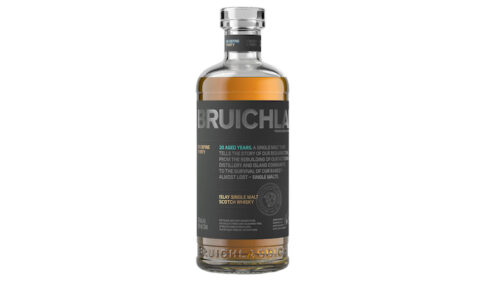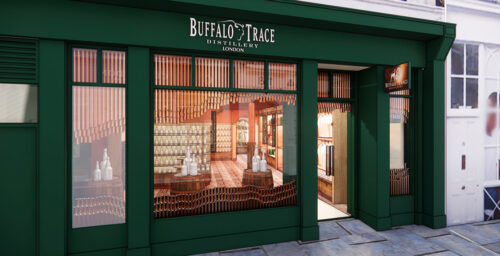Editor’s Note: While our focus here at The Whiskey Wash has always been whiskey, we do occasionally write about other spirits if we feel they will have relevance for our readership in the greater “whiskey lifestyle” consideration.
Raj Bhakta is one of those personalities that, over the years, has embraced many a calling depending upon his whim. Well established entrepreneur, former participant on Trump’s The Apprentice, candidate for a seat in the United States House of Representatives, founder of the popular rye whiskey brand WhistlePig. The list goes on.
Now, in his latest adventure, he is trying to convince whiskey drinkers and the like that ancient Armagnac, briefly finished in Islay whisky casks and sourced from an Armagnac house he acquired last year, should be the next big spirit they try. Why? Because he loves the fact it is very old, quite tasty and, at the price per bottle he has initially set it at, quite a bargain compared to Scotch that’s often a fraction of the age.
The name of Bhakta’s new venture is Bhakta Spirits, which he is running partially from his Bhakta Farms in Vermont (he also has the Armagnac house in France and another farm in Florida). The name of his new spirit is, simply enough, Bhakta Brandy. It is, more specifically, an Armagnac brandy blend (vintages within range from 1868-1970), 50 years of age, that’s been double finished for a short spell in first Islay whisky casks (two weeks) and then another Armagnac oak barrel (one week).
As it stands now, plans call for the equivalent of 38 barrels worth to be released, one batch at a time. The price, at least for the time being, is a mere $250 per 750 ml bottle. While that may seem like a chunk of change to many it is, as Bhakta once again sees it, a solid price to consider compared to older Scotches and also something he feels will appreciate as a collectible over time, making this initial investment well worth it.
So, is he on to something? Ultimately it will be the call of those who buy into it and the forces of the liquor market to decide. The journey to how he got to here and why he considers this his next big outing are worth considering, among other subjects, in this interview with him below. Note, as always, interviews we conduct are edited for clarity and brevity.
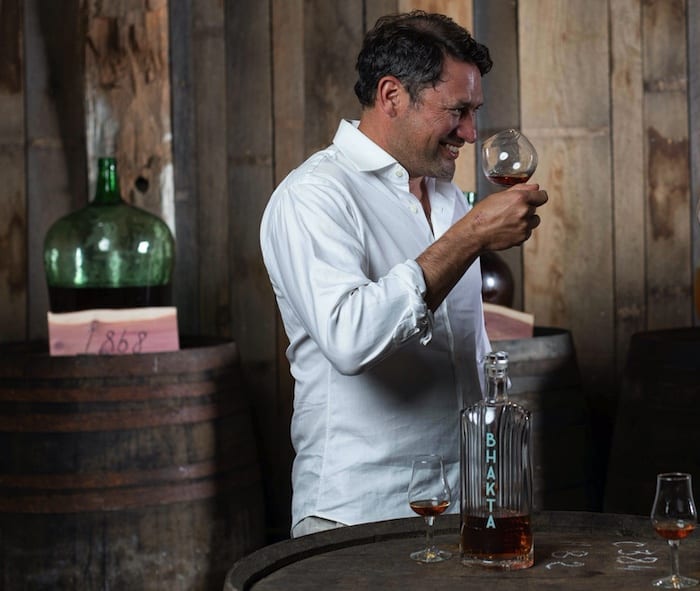
The Whiskey Wash (TWW): Raj, talk a little bit initially about your background as an entrepreneur.
Raj Bhakta: Entrepreneurship for me began very early. I had a job right out of college after I had an ill-fated short stint in the Marine Corps, which was ended by an injury. I ended up in investment banking. I very quickly saw that the call of starting a business was very strong, particularly when I saw a company that I had basically lined up the entire financing and purchase of the deal for 100 million, a deal that could have gotten done for 100 million, somebody else bought it and had sold it three months later for one billion.
I said, “Christ, I’m in the wrong part of the business. I need to be doing business myself as an entrepreneur.” That was, what, 1999, 2000? I started a dot com. I would say it was a success, that piece, in that I got my investors paid back but I didn’t make anything.
By about 2003, 2004, I was doing hotel development in Colorado, in Vail, with my family. I didn’t really enjoy working in the family business too much. I love my dad, but we banged heads a lot. I saw a peace with honor exit in going on The Apprentice, which I did in, what, ’04? I had the great honor of being fired, like many people, by our current president. That led into a couple of other things, but inevitably that TV appearance got me into political commentary, which turned into a congressional race, which I lost in 2006.
Then I went off to India, doing some soul searching and trying to find a replacement for Steve Irwin, who had just died. I said it would be really funny to have an Indian guy on the TV trying to chase and track these animals down but [that didn’t pan out]. Came back to America and felt like I had presided over a period of disasters. I couldn’t win a TV game show, I couldn’t win a congressional race, and I couldn’t find [the right guy] in a country of 1.4 billion. I felt like a big loser.
With whatever remaining dough I had, I bought a farm in Vermont and figured I would lick my wounds and wait until Jesus talked to me about what I should do next. That didn’t happen. Instead, we got the Great Recession. In ’08, I was basically broke with a defunct 500-acre dairy farm in Vermont. A friend came to me with a vodka opportunity. That got me looking at the spirits industry.
I decided I didn’t want to be in vodka because I like a business where the demand is greater than the supply, which is the opposite of vodka. Then I started looking at whiskey, which was my true passion and has always been my true passion. I looked at a company called Tuthilltown, which has got Hudson [Whiskey], a line that got bought by William Grant down the road.
I couldn’t make a deal happen with them, but I saw that there was a big opportunity in craft whiskey. That’s when I decided that, “Hell, I’ll do this myself,” and built a distillery.
This is what got me connected with Dave Pickerell, who had just left Maker’s Mark, and that was sort of a big, I would say, positive break. I owe Dave Pickerell a lot. In late 2009 – it was over my birthday on the farm – we became partners. He had a great supply of 10-year rye whiskey through a contact of his in Alberta, Canada, and that’s when WhistlePig began.
That was a little bit of the story there. I rode WhistlePig and built WhistlePig over basically 10 years, started it in 2010, I exited last year. I’ve spent really the past, I would say, two years, basically scouring the planet for the rare and the exquisite, and for great value. That’s what yielded Bhakta, this 50-year Armagnac finished in Islay casks, which is, I’m very, very confident, knowing the spirits industry very well, the greatest value on the entire planet in the world of spirits.
TWW: Let’s talk about WhistlePig for a minute. Tell us about your time and experience there. What did you learn about spirits and the potential for the industry as you were working with Dave while building that brand?
Bhakta: WhistlePig began as a combination of very modest beginnings and very big ambitions. To give you an idea, 10 years ago, over this past Fourth of July weekend, 10 years before launching Bhakta, I was launching WhistlePig. We had two picnic tables, one little Italian bottle filler, four summer interns, and an 85-year-old guy who I’d bought a Cadillac from, in a totally broken down barn.
Now, it is certainly the premier rye whiskey company in the country. I guess the experience there in a nutshell is if you offer something that is different, then the sky is the limit.
TWW: When you were at WhistlePig, what was it like working with whiskey on a day-to-day basis?
Bhakta: Working in the whiskey business day to day during WhistlePig was a blast. It was a tremendous amount of work. I largely stayed on the farm and built out the team, built up the sales force. People lived on the farm. It was me and my now wife, and our teams of new sales recruits that were coming in.
Frankly, it was like a capitalist kibbutz meets a frat house. It was a lot of fun. The company had a great sense of mission that we all were imbued with, which was basically to create America’s greatest whiskey brand, and in particular to put a dent in Scotch and get the American flag next to that of Scotland at the top shelf of restaurants, and bars, and liquor stores throughout the world. We made a lot of progress to that end.
TWW: When you were at WhistlePig, you spent a lot of time hanging out and working with Dave Pickerell, as you referenced him earlier in this interview. We know Dave has often been credited with being a sort of Johnny Appleseed of the craft whiskey industry in this day and age. What do you think you learned from him about being in the industry and how do you think that has helped you to look at things going forward?
Bhakta: Dave was a visionary and he got the WhistlePig vision very early on. Interestingly, despite Dave being known as the Johnny Appleseed of the business, Dave knew how to focus. He focused on no brand more than he focused on WhistlePig. Dave showed me the power of focus. Frankly, Dave worked very, very hard. Dave was out there communicating, on the road, every week, almost every day, throughout the entire country, for a decade, on behalf of WhistlePig.
I’ll tell you what Dave did, really. When I got into the business, everybody would tell me, “You don’t understand this business. This is a particular business.” I’d be talking with Dave and I’m like, “Dave, I don’t understand what they’re talking about. You have to get a product on the shelf, we need to be able to communicate to the consumer about that product, whether it’s the bartender or the retailer whose holding it, and tell them why this is such a great product, and then that product has to move. You need to get a product on the shelf and then it needs to move. That’s what it boils down to, placement and velocity.”
TWW: What do you want to say about your exit from WhistlePig, what happened there, how you feel about how things went down? Anything you want to say to folks about how you feel about the brand today?
Bhakta: I built WhistlePig into the country’s premier rye whiskey company, and when the time came and the tea leaves lined up that said it’s time to move on, I did. I’m very proud of what was built. I think it’s a great brand. It was my home. I wish them very well.
TWW: Ok, so what happens after that, just before you decide to do this Armagnac? What’s going on with you now that you’re sort of adrift from that?
Bhakta: Leaving WhistlePig was emotional. Obviously, I put my heart and soul into that brand. I put some distance between it physically. I moved down to Florida. Very shortly there after, I started traveling literally everywhere on the planet where there were old reserves [of spirits]: rum in the Caribbean, brandy in Africa, Spain, France, whiskey in the Americas, in India, in Japan. I literally scoured the Earth and really was driven by one simple objective: where can I find something that is rare, that is exquisite, and that has been overlooked?
Where I ended up finding that in spades was in [the] Armagnac [region], which had the history, which had the provenance, which had the age statements, which had really thousands of craft producers who take small wood-burning stills out into the fields in the season and make the Armagnac. It was like everything that you imagine in craft – that’s a lot of imagination, frankly, and not so much reality in America – was real there, in spades.
It became pretty clear to me that there really wasn’t anything like it on the planet. Think about Bhakta 50, with the 50-year-old age statement. I don’t think there’s any other spirits category where you can get a 50-year-old age statement for $250.
Now, admittedly, that price is going to go up and it’s going to go up fast, at least in my product line, but that pretty much says it in a nutshell. A 25-year-old bottle of Macallan is a $4,000 or $5,000 bottle. We’ve got something twice as old that, frankly, [that] costs eight times as much to distill, at five percent of the cost. That’s one of the accidents of history, that Armagnac, for whatever reason, just hasn’t popped.
The product is exquisite. It’s almost inexplicable to me how such a gem could have been overlooked for so long.
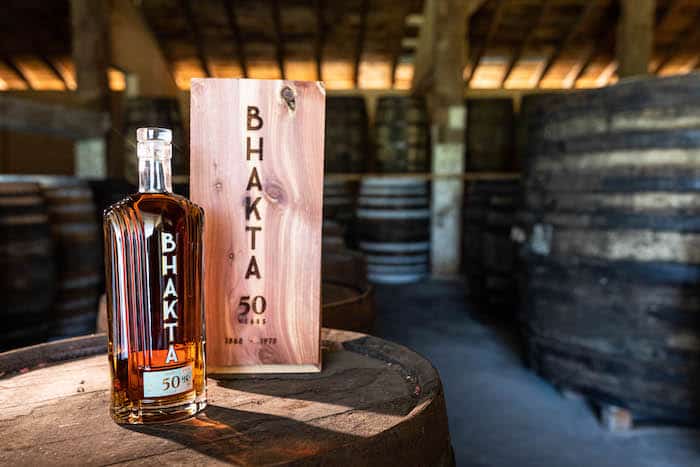
TWW: You dropped a bit off the spirits radar after WhistlePig. As you said, you were kind of searching around. Then a blurb appeared, a very small blurb, in news wires last year, about acquisition of an Armagnac house. Talk about your experiences in France and what led you to this particular place.
Bhakta: It’s a pretty funny story in France. I was actually spending some time in the Alps. My wife was not, for whatever reason, particularly happy with me, and had chased me out of the house with a broom so to speak. I got in the car and I drove over to Armagnac, which I had wanted to check out in any event.
I got in touch with a woman there named Amanda Garnham, who works for the regional body that’s charged with promoting Armagnac. She introduced me to people. I found that the house with the oldest stocks in the entire region, which means the entire world mind you, was interested in selling.
I made a couple of blunders, like blasting “Be Our Guest,” which my children were listening to, as I was driving into a chateau. My Escalade has got a hell of a sound system, so I’m screaming it at the top of my lungs and I pull into the courtyard, which has got like four stone walls and the music is blasting off all of them. This very staid Frenchman walks out and is not particularly impressed.
Things are very relationship based in the southwest of France. I stayed on it, and stayed focused and persistent on it, because I knew that this was really an irreplaceable asset, bottom line, and managed to make a deal happen. That deal took a solid year and a half of negotiations, of it dying and coming back to life, and price increases, then this guy would be pulling out. I’ve done a few deals. That one was the most complicated I’ve ever done.
TWW: So At this point in the interview, those who are reading it are probably thinking to themselves that “I drink whiskey, why should I care about Armagnac?” Frankly, why should whiskey drinkers care about Armagnac?
Bhakta: Because whiskey drinkers are being milked on a massive scale. Whiskey has been hot for over a decade now. They’re being overcharged for thin age statements and many products of dubious quality. I can say, as an authority on the matter, that whiskey is just totally overpriced. Whiskey is massively overpriced. Not everyone, granted, but the vast majority of products with age statements on it are grotesquely overpriced, relative to what’s available in the spirits world.
Now, granted, I have a vested interest in this, but I know whiskey very, very well and I was part of creating the whiskey boom. I’m very well aware of my role of creating the whiskey boom and high whiskey prices, but that also helped me realize what a tremendous value there is in Armagnac, which really tastes like a whiskey. It’s very rich, it’s very flavorful.
Look, let’s just go by the numbers. Armagnac brandy is a much more expensive spirit to make because there’s a much more pricey, delicate inputs, in this case grape. It’s between six and eight times as much to produce. That’s because grain takes about six months to grow and costs a couple of hundred dollars an acre to grow. Grapes don’t start producing for three or four years, and they cost $15,000-$16,000 to plant, on the low side, and you have to spend a fortune each year pruning them.
It’s not even the same, grape versus grain. We’re distilling fine wine, whiskey is distilling beer. Then add the Bhakta finishing method [and] the fact that we’re getting some of the best flavor attributes. Even through a short kiss by whisky barrels, you taste it and you’ll realize that, frankly, yeah, you’re being overcharged. My message to the whiskey drinker is you’re being raped.
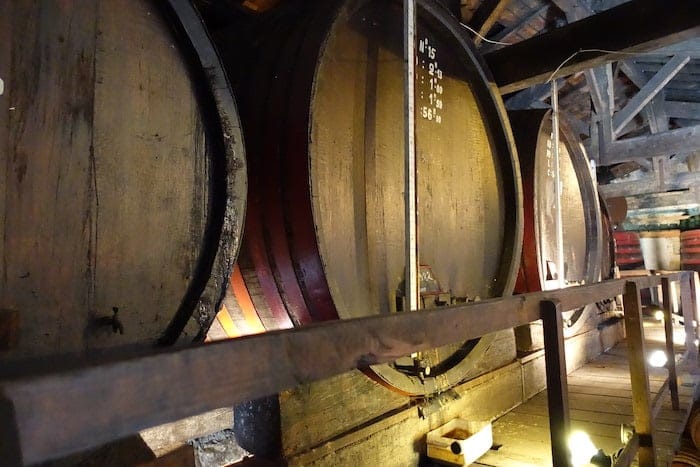
TWW: When you think about the whiskey drinker that’s looking at other spirits categories to consider, brandy has certainly been one that’s been referenced all over the place. There’s a range of brandy types, particularly there in Europe. Why did you go Armagnac versus, say, Cognac or a brandy from Spain or something like that? What was it about that particular category that appeals to you so much?
Bhakta: Quality and value. Armagnac offers unparalleled quality and value. Cognac is the value coefficient of zero. Cognac is very expensive. It’s great product, but it’s very expensive. Armagnac is more flavorful than Cognac, and it has not been promoted. Armagnac doesn’t have a Hennessy, doesn’t have a Remy, doesn’t have anything like the big houses. This is all about the product.
When you taste the product and when you look at the age profile on it, it can’t be replaced. The age statement is one thing that can’t lie. You can age for too long, but Armagnac, because of the types of barrels it’s been in, can be aged for a very long time.
50 years is a fantastic age statement on the product, and it is appropriate for the product. There’s nothing like it in the world of spirits for the whiskey drinker, and again, let me tell you, I am a whiskey guy. I love whiskey and I have drank whiskey all my life. I was probably the first underaged member of the American Bourbon Society. What I want to do is deliver great value to the consumer, and this is the greatest value that I could find.
It’s not cheap, by any means, but it is, for the money, at $250 for a 50 year old bottle of Bhakta – and that price is going to be going up quarterly by the way – unparalleled. That’s why I ended up there.
TWW: In America, bourbon has long been the dominant whiskey. In France, and other parts of the world, Cognac has long been the dominant brandy type. You came in, did rye whiskey, which was an underdog. You are now doing Armagnac, which many people consider an underdog to Cognac. How do you look at Armagnac and see it potentially being a success like that?
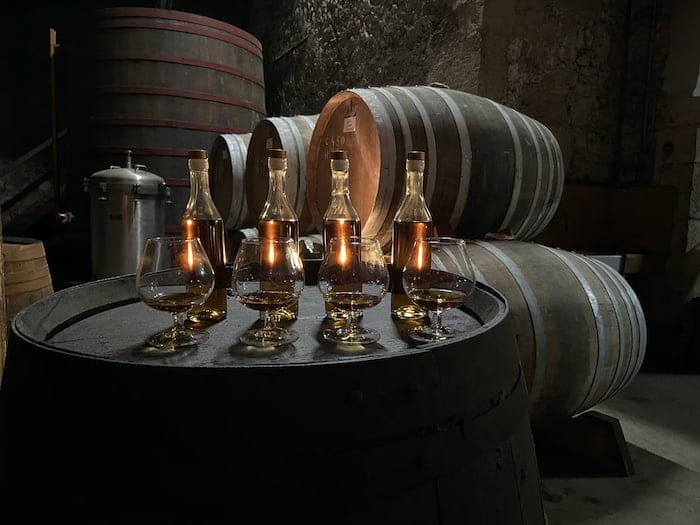
Bhakta: I see Armagnac is to Cognac what rye was to bourbon 10 years ago. What does that mean? That rye has got more flavor than bourbon. If you’re looking for flavor, rye is the choice – it just needs to be older, right? The same thing is true of Armagnac. Armagnac needs to be older than Cognac because it’s only once distilled. It’s a little rougher when it’s in its youth than Cognac is, because Cognac is at least double-distilled and put through a pot.
Armagnac is not. Armagnac needs more time. That’s the same thing of rye. I feel like basically what I’m doing with Armagnac is the same thing I did with rye whiskey, which is bring a forgotten and overlooked spirits category to the forefront of awareness and the light of day that it deserves.
TWW: Let’s talk specifics about Bhakta Brandy now. What is it? What are you hoping to do with it?
Bhakta: Bhakta 50, which is our first release, is a combination of vintages that start in 1868 and that end in 1970. The [other vintages] are 1897, 1939, 1946, 1956, 1963, 1965. It’s eight vintages in total, and it’s over 150 years at its oldest and at least 50 years at its youngest.
It is, to me, an ability to taste history. The product itself is absolutely exquisite, but the amazing thing to me is that you’re able to taste so far deep into the past. Let’s look at the 1868 vintage. The 1868 vintage was put into wood that was at least 100 years old. Some of the barrels would have been older. It’s a product that’s been in the making for 250 years. We’ve got 38 barrels that are being released this year. That number of barrels is actually going to be going down as time moves on, and the prices are going to be moving up, probably to the tune of at least $100 a year.
I want to bring people into the category. What I’m offering, like the [WhistlePig] Boss Hog releases that came out very early, [is something that] will also be an appreciating asset. This is an investment. This is an opportunity to own time in a bottle. I recommend that people buy one to drink and keep one as an investment, because that second bottle will more than pay for the one that they drank over time.
To taste something so old, that has got so much history in it, that slept through two World Wars, that began when there was this guy named Napoleon III who was on the throne of France, when France was an empire and Queen Victoria was in the middle of her reign. [The cognac] Louis XIII has like a drop of something that’s 100 years old in it. This has got more than that, that’s over 150 years old. That’s because of the accident of history and the very existence of Armagnac.
TWW: You’ve done something interesting here with this product. You put it for a very brief finishing period in Islay Scotch whisky casks. Why, and how do you feel purists feel about that, and what do you have to say to them?
Bhakta: I would tell the purists to lighten up and enjoy themselves. I would say to the audience as a whole, try it. I’ll tell you how it happened for me. I’m a whiskey guy. I’ve very clearly been a whiskey guy all my life. I happened to be meeting with a French farmer who lost a bet to a Scotsman and they had to exchange barrels. He put his Armagnac into a Scotch barrel which had a fair degree of smoke in it. I tasted it, and it was a eureka moment in that it fused the best of both worlds. It still had all of the complexity, elegance, and some of the sweetness of the brandy, but it also had the element of smoke, which balanced it very, very well.
Then I knew I had lightning in a bottle, and I knew it would appeal both to a brandy drinker, which is a big market, and the whiskey drinker. The abused whiskey drinker who’s been paying such ridiculously high prices for products that just don’t deserve the high prices.
That was the moment that I came up with the Bhakta method, which I frankly owe the French farmer a debt of gratitude for. It’s the combination of two worlds, which is better together. The whole is better than the sum of the parts. It’s a very light touch. You just get a little tiny kiss of the smoke, which transfigures the product in a sublime way.
TWW: How does that brief exposure to the defined key smokiness of typical Islay casks play with the earthiness of Armagnac?
Bhakta: It brings it a bounce. First of all, you don’t want to use it overly in our vintages, even though they’re very old they’re remarkably youthful and vibrant. If you have a well balanced brightness to your underlying Armagnac, despite the age, it creates that balance. The Armagnac, it’s a fruit. It’s a grape distillate. It’s a distilled wine. It has an element of, I would say, sweetness and caramel to it.
Just a pinch of smoke gives it that balance. What I look for in a spirit, and I think we did this very well in WhistlePig, [is that like] what you want in your best friend, is what you want in your favorite drink. That’s the appropriate balance between character and smoothness.
Now, they’re normally, in people and in spirits, inversely proportional. You meet somebody with a huge character, they’re not particularly smooth. Right? You meet somebody super smooth, they don’t have much character normally. Right? You don’t want to sit next to a totally boring guy on a flight to China. Nor do you want to sit next to a guy like me who’s going to be talking to you the whole time on the whole flight to China. You want the balance.
What we did with this whisky [cask] finish is bring an extraordinary balance between character, and smoothness, and complexity into one product. In the smoothness category, we’re way up there. In the character category, we’re way up there. That’s what you want in a drink and a best friend.
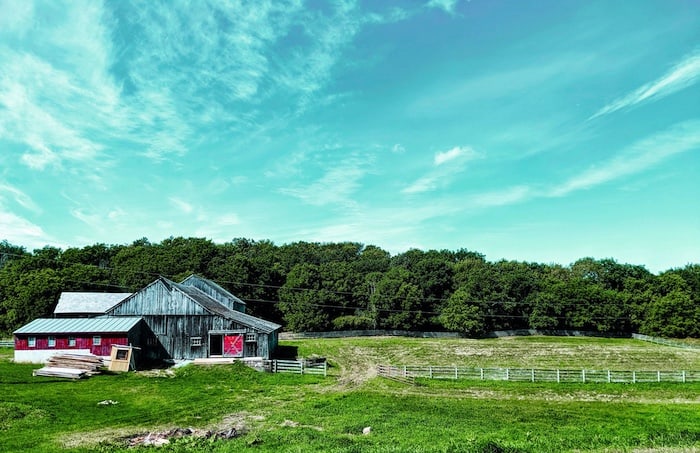
TWW: Something I’ve read in the literature around your new release is that you did some other barrel finishing after the Islay cask. Can you talk a little about that and why you did that?
Bhakta: We have, between the property in France, and the property in Vermont, and also down in Florida, a world-class variety of whisky barrels, rum barrels, rye, bourbon, you name it. One of the things that I found interesting is that given the age of the spirits, the addition of smoke, we did the blend, we put it in the Scotch cask and I said, “Okay, let’s put it back in a variety of different casks.”
I put one in a very young cask that had just had eau de vie dumped from it, only about six months old. A very fresh barrel with very young juice in it. It brightened it, and that sort of put the vim and vigor of youth and happiness into an otherwise delicious but ancient and more earthy tasting product. It doesn’t really have per se any eau de vie in it, but it gets a little kiss of youth in that final finish. Which isn’t in every barrel, by the way.
TWW: There are regulations both in France and the US about how spirits are labeled, and bottled, and finished. How did you navigate those regulations in coming up with this final product? It’s very uncommon for French brandy to be finished in anything.
Bhakta: The American guidelines are more liberal than the French. The French guidelines are very strict. The moment you put Armagnac into a whisky cask, even if it’s French oak, you can’t call it Armagnac anymore. Which is why brandy is on the label and we say on the back label, “This is Armagnac finished in whiskey casks.”
I don’t think it’s good for them to be so strict, but I’m not going to complain. Maybe it’s because of their strictness and their rules that I was able to buy such ancient stock in the first place. I would love to call it Armagnac, which it is, but I feel like having the freedom and the flexibility to bring American innovation to an ancient product is key.
TWW: You’ve got now this French brandy, Armagnac, that you’re bringing it to American drinkers. A very small number of American drinkers, whiskey or otherwise, know what Armagnac is. What do you want to say to them, particularly whiskey drinkers, in how to consider and approach your product?
Bhakta: To the whiskey drinker, this is a different product. You’re going to have a different taste profile. I would take a very small sip first, and just sort of let the deeper layers of complexity and age slowly seep in. Don’t take a slug. Take a very small sip, let it wash about the mouth. Chew it slowly. Do that a couple of times.
I would generally for the first time drink it chilled, because it’s pretty high proof. If you pull it out of the back of your car and drink it from Arizona it’s going to be hot, I guess like anything. I think that chilling it will actually allow you to pick up more of the complexity and the desired notes. Or, I’d drink it with a cube of ice if that’s the way you like it, but very clean, clear ice.
This is a very rare and exquisite product. I would recommend approaching Bhakta 50 like you would a first date. Don’t jump in like a screaming madman. Just sort of ease into it and get a feel for the counterparty. I think the whiskey drinker will see that this is something which has got the best attributes of whiskey amplified, plus some of the best attributes of brandy.
TWW: Through parts of this interview you’ve referenced this as a collectible. How do you look at it as one who drinks spirits? What does this evoke for you when you’re sitting down, either in France, or Vermont, or wherever, and sipping some of it? What do you feel with it?
Bhakta: What I feel is a magical experience. I think about the different blends that go into it. The 1970 is the youngest. We’d just put a man on the moon. The 1963, the Beatles, JFK’s assassination. I think of history. I think of 1939 as the war clouds gathered in World War II in Europe. I think of 1946 when things liberated. I think of 1897 as America is just really coming on to the world stage before the Spanish-American War. I think about 1868 when we just finished the Civil War and what the world was like then.
All of those things are in there. It’s over 250 years of history. I can’t tell you that I don’t feel at the same time this tinge of guilt that this is almost so rare, and I know what the stocks are of all the spirits in the world, this is so rare that I shouldn’t even be drinking it. But then what’s the point of it if you don’t drink it? I don’t know,
I would say it’s a comprehensive metaphysical experience.
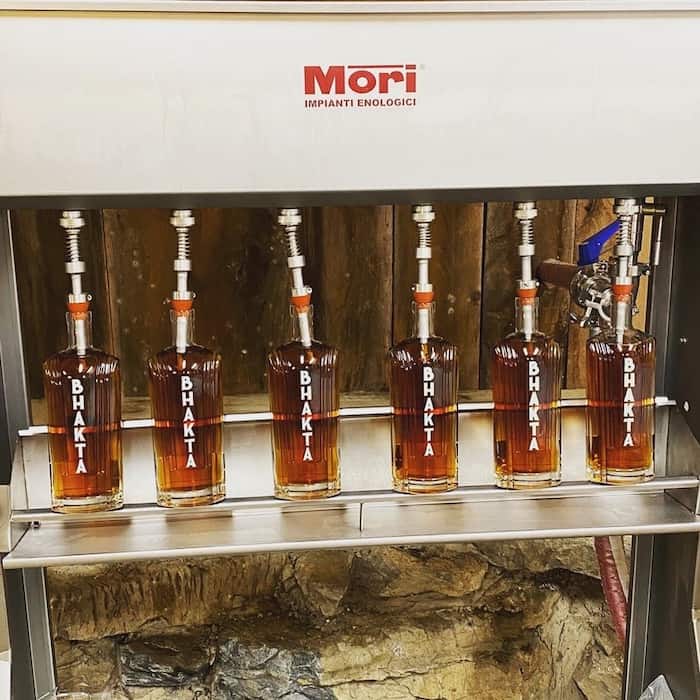
TWW: Your greater label is Bhakta Spirits. What is next for you, including the brandy?
Bhakta: I’m going to focus on building out this brand. I’m going to stay true to my mission, which is delivering particularly the whiskey drinker the greatest value in the world of spirits, and I’m just going to keep doing that. I think if you’ve got a superior product and you’re able to communicate that, and you have something that’s fundamentally rare and exquisite and you’re able to communicate that, that there’s a long, long way to go.
I think we’ll have this 50-year-old, we’ll put out a 35-year-old, which is 2X the age statements of almost anything you see in the whiskey world. I’ll put out an 18-year-old.
Then we’ll back in, just like I did with WhistlePig, to a farm-based production, but that’s going to be some time off. I see a Napoleon, which is a six-year, in the coming. We’ll probably bring some product from France to get that going, as we slowly increase the amount of distillate that we have done from our farm in Vermont, which is currently under a pretty aggressive vineyard planting program. The idea is to create the greatest spirits brand on the planet.
TWW: Talk for a moment about your Vermont farm and the vineyard there. Vermont is not exactly a major category for either wine or brandy. What are you doing there?
Bhakta: In Vermont we’re planting. There are a couple of very good wineries in Vermont. Particularly close to me is Lincoln Peak, that does a terrific job, although they’re slowing down and retiring now. Vermont produces some great wines. It’s particularly great for its high acidity white varieties. It’s not for everybody, in terms of wine. For brandy, it’s perfect. You want the high acidity white grape to make brandy.
From everything that I’m hearing from the people who have done it in France, particularly our producer partners in France who have been helping us here as well as some of the local wine producers in Vermont, there is no reason to believe we can’t create a unique, world-class product off the farm.
I think any product that you buy to put in your mouth, you should be able to trace it back to its point of origin and know that, for example, I live here with my family and I’m out in the fields every day on the farm overseeing it. I’ve learned a lot about vineyards, which are very high maintenance by the way and there’s a lot to it. I believe deeply in that.
I think that’s part of what made WhistlePig successful. It was a big part of what made WhistlePig successful, that there was a real home to the brand where we were actually doing an ancient form of farming which was growing the grain and turning it into whiskey. Now we’re doing the same thing with wine. To me, it’s better if the company is family owned and you have your family there, that it’s not a bunch of faceless bankers.
TWW: Do you think Vermont brandy could be something someday? When we think about domestic brandy production in the US, it is not as well established as whiskey. We think about California brandy, but there’s no real major domestic brandy regional category for the most part.
Bhakta: I can say this. There was no American rye whiskey before WhistlePig really. We were an early mover, and we got our stock from Canada, and now it’s an American product. It’s the same thing here. Bhakta is taking the very best attributes of an ancient brandy distilling region, particularly that of Armagnac, bringing its best attributes to the new world.
I fully expect that Bhakta brandy will be a great and famous brand, highly valuable in time, and that the distillate that we produce here will be truly world class. Do I expect consumers throughout the world to be asking for the newest Vermont brandy? No. Do I expect consumers around the world to be asking for Bhakta in the decades to come? Yes. Do I expect the people who buy early bottles of Bhakta to have made small fortunes? Yes. I’m a believer.
TWW: All right, Raj. Thank you for your time and for the interview. We appreciate it.
Bhakta: Thank you.







